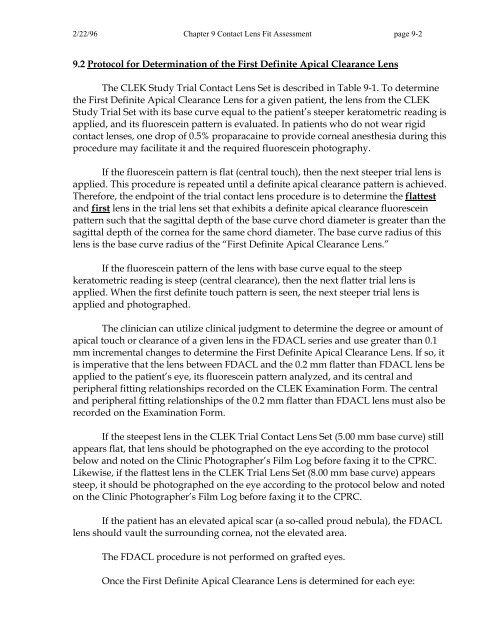OM t of c.iii - Vision Research Coordinating Center - Washington ...
OM t of c.iii - Vision Research Coordinating Center - Washington ...
OM t of c.iii - Vision Research Coordinating Center - Washington ...
You also want an ePaper? Increase the reach of your titles
YUMPU automatically turns print PDFs into web optimized ePapers that Google loves.
2/22/96 Chapter 9 Contact Lens Fit Assessment page 9-2<br />
9.2 Protocol for Determination <strong>of</strong> the First Definite Apical Clearance Lens<br />
The CLEK Study Trial Contact Lens Set is described in Table 9-1. To determine<br />
the First Definite Apical Clearance Lens for a given patient, the lens from the CLEK<br />
Study Trial Set with its base curve equal to the patient’s steeper keratometric reading is<br />
applied, and its fluorescein pattern is evaluated. In patients who do not wear rigid<br />
contact lenses, one drop <strong>of</strong> 0.5% proparacaine to provide corneal anesthesia during this<br />
procedure may facilitate it and the required fluorescein photography.<br />
If the fluorescein pattern is flat (central touch), then the next steeper trial lens is<br />
applied. This procedure is repeated until a definite apical clearance pattern is achieved.<br />
Therefore, the endpoint <strong>of</strong> the trial contact lens procedure is to determine the flattest<br />
and first lens in the trial lens set that exhibits a definite apical clearance fluorescein<br />
pattern such that the sagittal depth <strong>of</strong> the base curve chord diameter is greater than the<br />
sagittal depth <strong>of</strong> the cornea for the same chord diameter. The base curve radius <strong>of</strong> this<br />
lens is the base curve radius <strong>of</strong> the “First Definite Apical Clearance Lens.”<br />
If the fluorescein pattern <strong>of</strong> the lens with base curve equal to the steep<br />
keratometric reading is steep (central clearance), then the next flatter trial lens is<br />
applied. When the first definite touch pattern is seen, the next steeper trial lens is<br />
applied and photographed.<br />
The clinician can utilize clinical judgment to determine the degree or amount <strong>of</strong><br />
apical touch or clearance <strong>of</strong> a given lens in the FDACL series and use greater than 0.1<br />
mm incremental changes to determine the First Definite Apical Clearance Lens. If so, it<br />
is imperative that the lens between FDACL and the 0.2 mm flatter than FDACL lens be<br />
applied to the patient’s eye, its fluorescein pattern analyzed, and its central and<br />
peripheral fitting relationships recorded on the CLEK Examination Form. The central<br />
and peripheral fitting relationships <strong>of</strong> the 0.2 mm flatter than FDACL lens must also be<br />
recorded on the Examination Form.<br />
If the steepest lens in the CLEK Trial Contact Lens Set (5.00 mm base curve) still<br />
appears flat, that lens should be photographed on the eye according to the protocol<br />
below and noted on the Clinic Photographer’s Film Log before faxing it to the CPRC.<br />
Likewise, if the flattest lens in the CLEK Trial Lens Set (8.00 mm base curve) appears<br />
steep, it should be photographed on the eye according to the protocol below and noted<br />
on the Clinic Photographer’s Film Log before faxing it to the CPRC.<br />
If the patient has an elevated apical scar (a so-called proud nebula), the FDACL<br />
lens should vault the surrounding cornea, not the elevated area.<br />
The FDACL procedure is not performed on grafted eyes.<br />
Once the First Definite Apical Clearance Lens is determined for each eye:
















